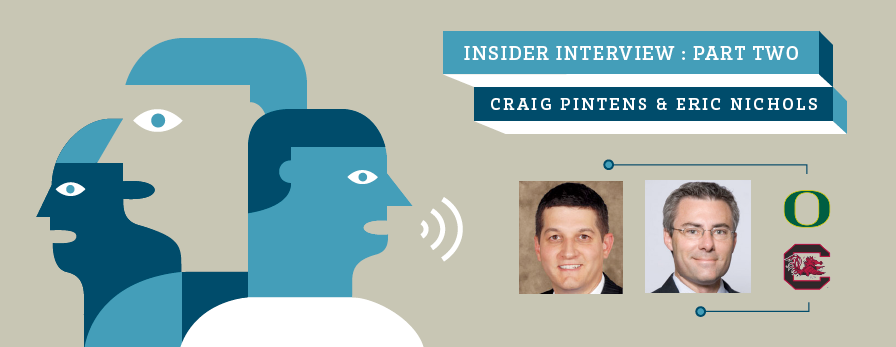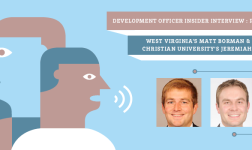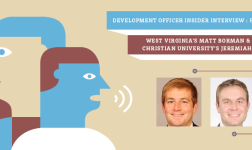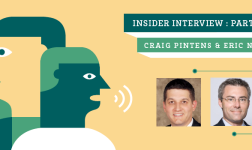
Our first insiders are Craig Pintens—Senior Associate Athletic Director for Marketing & Public Relations at the University of Oregon—and Eric Nichols, Assistant AD and Director of Marketing for the University of South Carolina. Craig is the president of NACMA—the National Association of Collegiate Marketing Administrators—and Eric is the first Vice President.
Both Craig and Eric have overseen major national marketing campaigns and are considered to be two of the most innovative strategists in college marketing. Both were good enough to sit down with Ryan Matthews, Winthrop’s Managing Editor, to discuss current trends in fan engagement, growing revenues, and increasing attendance.
Winthrop intelligence is pleased to present our first Insider Interview, letting key leaders in college sports go deeper by passing off the mic, for one-on-one expert interviews.
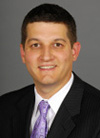 Craig Pintens – University of Oregon
Craig Pintens – University of Oregon
Senior Associate Athletic Director/Marketing & Public Relations
 Eric Nichols – University of South Carolina
Eric Nichols – University of South Carolina
Associate AD/CMO
ERIC NICHOLS – What are you guys doing as far as data and research?
CRAIG PINTENS – Well, we probably need to get better in that area. I think that’s common in college athletics. Chief Marketing Officer Round Table: Best Practices, Trends & TechnologyIn the fast-paced world of college athletics marketing—where the sophistication of promotion is continually increasing, evolving, and growing more refined—chief marketing officers…read more. One of the things that is often forgotten is that we don’t spend enough money on market research. If you worked for a marketing firm, you would spend X number of you marketing dollars to research your consumers.
I think sometimes we take for granted who we have. Because college athletics has such a devoted fan base, it’s unlike almost anything out there. We need to do a better job. We’ve done some surveys, but again, if you’re just doing a survey and you have data…I’ll use the toothbrush analogy. If you brush your teeth, but you don’t see the dentist, you won’t be in good shape. You need an expert. You need to take the data you have and be able to interpret it.
ERIC NICHOLS – To your point about paying for research—it cost us $25,000 to do for the market research. But you talk about sales? Many times marketers are evaluated on ticket sales and outside revenue, but some of my best sales jobs have been trying to convince people to spend $25,000 on research. That was a very tough deal. Of course I didn’t convince them, we got someone else to pay for it.
CRAIG PINTENS – If you can spend $25,000 on campus you should just be a one-man ticket operation. You could sell out every venue that you have.
ERIC NICHOLS – Yeah, I think I shot the one bullet that I had.
CRAIG PINTENS – Probably a well placed bullet.
ERIC NICHOLS – You guys are the self-anointed hashtag: “national brand.”
CRAIG PINTENS – Thanks.
ERIC NICHOLS – That was a shot. You like that?
CRAIG PINTENS – I did.
ERIC NICHOLS – Well, we’re a self-anointed top-ten football program.
CRAIG PINTENS – I did notice that. But you said earlier, you are what your fans say you are, and if you tell them that enough, they might actually believe it. I guess that’s part of our job.
ERIC NICHOLS – I might need to tell them that they have an awesome person overseeing their marketing efforts.
CRAIG PINTENS – Stay off the message boards.
ERIC NICHOLS – How have you made Oregon, all kidding aside, you are a national brand and probably an international brand. I don’t have any data to back that up, but how have you grown, and how have you leveraged, that national platform.
CRAIG PINTENS – Thanks. For us the goal is to be the national brand in college athletics, not just a national brand. That’s what we’re constantly striving for. And that’s where we do use a lot of research on the merchandising side. For us, 81.3% of our merchandise is purchased outside of the state of Oregon, that’s a very high percentage. In talking to industry experts, it’s well above what the industry average is and it’s among the highest in college athletics, if not the highest. Our merchandising numbers are very strong, you can compare them against anybody, especially with the vendor that we use for our online shop. So, for us, it’s about growing that.
But it’s a bigger concept for us. And that’s where social media can play a big role. People talk about social media and ask “what’s the return on investment?” You talk about $25,000 for market research…try to get money to spend on social media is in the same boat because there’s no return on investment. But long term, there’s a huge return. For us, it is about that fan engagement. And if we can engage with our fans and help spread the message, we’re doing something right.
An example would be yesterday with our new football building getting a lot of coverage. For us that helps position us.
ERIC NICHOLS – Now take us through that thought process. I think you had a media day without any players. It was just the facility, correct?
CRAIG PINTENS – It was. And the facility can’t talk so it was very interesting. We worked with the architect—the firm was ZGF, they did a fantastic job—the building is amazing. We worked with them and Sports Illustrated. SI did an exclusive and it’s on newsstands now. They did some great video stuff, they did an online photo gallery. That was all coordinated to be released yesterday. Beyond that we invited national writers to come and get a tour of the building, and to have some exclusive access inside. They were here yesterday and as a result we received a lot of great coverage.
Beyond that, we’re really becoming our own news agency. So for us, releasing a photo gallery and releasing a video, most of the photos and videos that were used yesterday came from us. We created a lot of that news. Too often people get caught up, and having transitioned into a little bit different role here at Oregon, people focus so much on traditional means of marketing or focus on their marketing plan.
Your marketing plan better include some form of publicity because that’s the best kind of marketing. We didn’t spend a dime on any of the coverage we got yesterday, but if you put a dollar figure on it—I guess we need to hire your research firm from South Carolina to do that—but if you put a dollar figure on that it would be a pretty high value.
ERIC NICHOLS – In the business marketing and media relations are two different department and I assume they are somewhat like that on your campus—do you see them merging together? How do you see those two departments changing in the next few years?
CRAIG PINTENS – Oh, it’s changing, it has changed. We really are one. In about a week or so, we’re going to move into a new space in our building. One of the fortunate things about football vacating is that it freed up some space for us. So we’re moving into a marketing and communications suite, where everybody is going to be in the same space and it’s going to have an open concept where you’ll have everybody in a big space with open offices. We will have some privacy areas where you can take some phone calls. We’ll also relocate the Quack Cave, our social media command center, and we’ll have them in there as well.
You have to work hand-in-hand. We just had a meeting this morning about Men’s Basketball tickets and our campaign includes notifying the press that tickets are on sale and getting as much free advertising as we can.
I know we’ve talked about this before privately, Eric, about the merging of everything—how do you guys get the right coverage? A great example is what you guys did with Jadeveon Clowney and the ESPYs, how do you coordinate something like that?
ERIC NICHOLS – Ours is coming along a little bit slower, we may be a little bit understaffed on the media relations side as compared to some of our peers. So many of the traditional day-to-day SID duties are still needing to be met, but what we’ve started to do—we got this idea from Ole Miss, actually—we’ve broken into teams. Unofficial teams, so to speak, but when there’s a sport that we need to market or an opportunity that we need to take advantage of like the ESPYs, we’ll get together.
It’s marketing, it’s media relations, our Senior Associate for External Operations and we put together a plan—but it’s all based on garnering publicity. And oh by the way, that publicity, after he wins the ESPYs we have a big sales day for football season tickets. So they all go hand in hand. But we attack it in teams. I just got out of a meeting about basketball and it’s SID, marketing, facilities, basketball opps. So while structurally it hasn’t changed, our procedures, and our practices, and our efforts are definitely merging together.
From my office, we have a—I call it the seven pillars of a promotion—and it’s such a silly, gimmicky name, but it’s seven columns that go into a successful promotion. Of those columns, one of them is our media. We go back to that SID, and we say: “how can we generate some earned media versus Mississippi State?” It challenges us to think like a PR person and for the SID, it challenges them to work like a marketing person.

